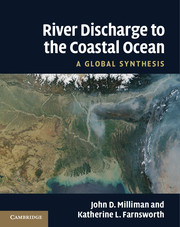Book contents
- Frontmatter
- Contents
- Foreword
- 1 Introduction
- 2 Runoff, erosion, and delivery to the coastal ocean
- 3 Temporal variations
- 4 Human activities and their impacts
- Appendices. Global river data base
- Appendix A North and Central America
- Appendix B South America
- Appendix C Europe
- Appendix D Africa
- Appendix E Eurasia
- Appendix F Asia
- Appendix G Oceania
- References
- Indexes
3 - Temporal variations
Published online by Cambridge University Press: 03 May 2011
- Frontmatter
- Contents
- Foreword
- 1 Introduction
- 2 Runoff, erosion, and delivery to the coastal ocean
- 3 Temporal variations
- 4 Human activities and their impacts
- Appendices. Global river data base
- Appendix A North and Central America
- Appendix B South America
- Appendix C Europe
- Appendix D Africa
- Appendix E Eurasia
- Appendix F Asia
- Appendix G Oceania
- References
- Indexes
Summary
Small showers last long,
But sudden storms are short
W. ShakespeareThe past is over
G. W. BushIntroduction
The numbers and broad arrows shown in Figures 2.9, 2.30, 2.38, and 2.49 portray mean annual river discharges of water, suspended sediment, dissolved solids, and dissolved silica, respectively, to the global ocean; they are based on the database presented in the appendix. Because these data for the most part represent long-term means, discharges for any given year, month or hour can vary greatly. The large discharge arrows emanating from southern Asia in Fig. 2.11d, for example, primarily reflects fluvial response to intense summer monsoon precipitation and Himalayan snowmelt. For seven months of the year much of southern Asia can be considered arid and arrows on Fig. 2.11d would thus be correspondingly smaller. Over longer periods of time – years to decades – slight shifts in climatic drivers (e.g. El Niño-Southern Oscillation or the North Atlantic Oscillation) can lead to significant shifts in river flow (Knox, 1995; Liu and Wang, 1999). As we delve further into the past and as our links to present-day measurements and environmental conditions become less certain, the uncertainties of river flow increase. How, for example, did local, regional or global river discharge change during the last glacial maximum (LGM); or how did Asian river discharge respond to the Miocene uplift of what is now the Himalayas?
- Type
- Chapter
- Information
- River Discharge to the Coastal OceanA Global Synthesis, pp. 70 - 114Publisher: Cambridge University PressPrint publication year: 2011



